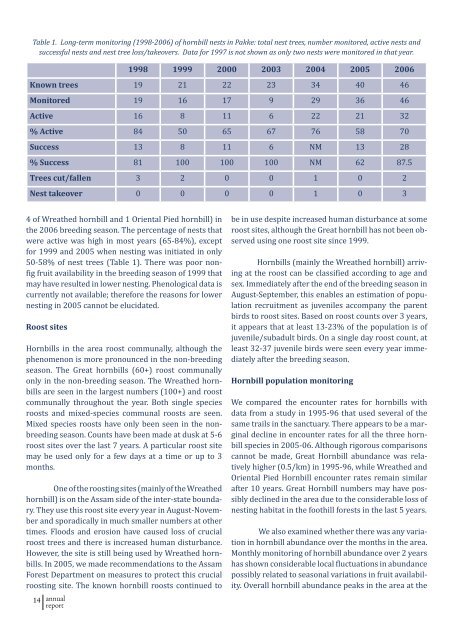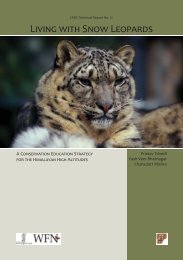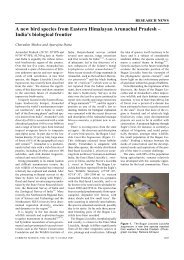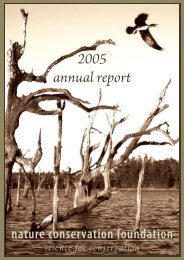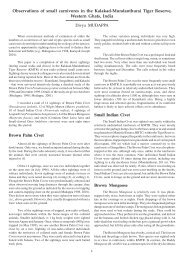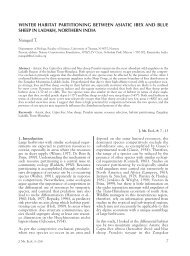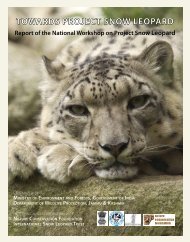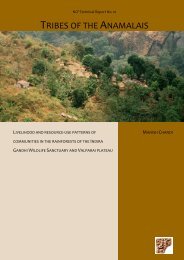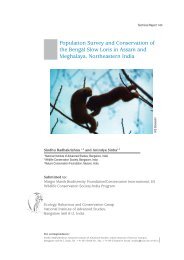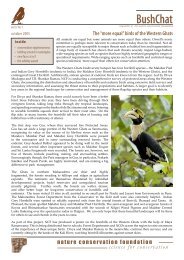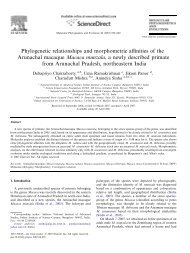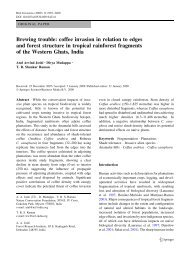2006-7 annual report - Nature Conservation Foundation
2006-7 annual report - Nature Conservation Foundation
2006-7 annual report - Nature Conservation Foundation
Create successful ePaper yourself
Turn your PDF publications into a flip-book with our unique Google optimized e-Paper software.
Table 1. Long-term monitoring (1998-<strong>2006</strong>) of hornbill nests in Pakke: total nest trees, number monitored, active nests and<br />
successful nests and nest tree loss/takeovers. Data for 1997 is not shown as only two nests were monitored in that year.<br />
1998 1999 2000 2003 2004 2005 <strong>2006</strong><br />
Known trees 19 21 22 23 34 40 46<br />
Monitored 19 16 17 9 29 36 46<br />
Active 16 8 11 6 22 21 32<br />
% Active 84 50 65 67 76 58 70<br />
Success 13 8 11 6 NM 13 28<br />
% Success 81 100 100 100 NM 62 87.5<br />
Trees cut/fallen 3 2 0 0 1 0 2<br />
Nest takeover 0 0 0 0 1 0 3<br />
4 of Wreathed hornbill and 1 Oriental Pied hornbill) in<br />
the <strong>2006</strong> breeding season. The percentage of nests that<br />
were active was high in most years (65-84%), except<br />
for 1999 and 2005 when nesting was initiated in only<br />
50-58% of nest trees (Table 1). There was poor nonfig<br />
fruit availability in the breeding season of 1999 that<br />
may have resulted in lower nesting. Phenological data is<br />
currently not available; therefore the reasons for lower<br />
nesting in 2005 cannot be elucidated.<br />
Roost sites<br />
Hornbills in the area roost communally, although the<br />
phenomenon is more pronounced in the non-breeding<br />
season. The Great hornbills (60+) roost communally<br />
only in the non-breeding season. The Wreathed hornbills<br />
are seen in the largest numbers (100+) and roost<br />
communally throughout the year. Both single species<br />
roosts and mixed-species communal roosts are seen.<br />
Mixed species roosts have only been seen in the nonbreeding<br />
season. Counts have been made at dusk at 5-6<br />
roost sites over the last 7 years. A particular roost site<br />
may be used only for a few days at a time or up to 3<br />
months.<br />
One of the roosting sites (mainly of the Wreathed<br />
hornbill) is on the Assam side of the inter-state boundary.<br />
They use this roost site every year in August-November<br />
and sporadically in much smaller numbers at other<br />
times. Floods and erosion have caused loss of crucial<br />
roost trees and there is increased human disturbance.<br />
However, the site is still being used by Wreathed hornbills.<br />
In 2005, we made recommendations to the Assam<br />
Forest Department on measures to protect this crucial<br />
roosting site. The known hornbill roosts continued to<br />
14<br />
<strong>annual</strong><br />
<strong>report</strong><br />
be in use despite increased human disturbance at some<br />
roost sites, although the Great hornbill has not been observed<br />
using one roost site since 1999.<br />
Hornbills (mainly the Wreathed hornbill) arriving<br />
at the roost can be classified according to age and<br />
sex. Immediately after the end of the breeding season in<br />
August-September, this enables an estimation of population<br />
recruitment as juveniles accompany the parent<br />
birds to roost sites. Based on roost counts over 3 years,<br />
it appears that at least 13-23% of the population is of<br />
juvenile/subadult birds. On a single day roost count, at<br />
least 32-37 juvenile birds were seen every year immediately<br />
after the breeding season.<br />
Hornbill population monitoring<br />
We compared the encounter rates for hornbills with<br />
data from a study in 1995-96 that used several of the<br />
same trails in the sanctuary. There appears to be a marginal<br />
decline in encounter rates for all the three hornbill<br />
species in 2005-06. Although rigorous comparisons<br />
cannot be made, Great Hornbill abundance was relatively<br />
higher (0.5/km) in 1995-96, while Wreathed and<br />
Oriental Pied Hornbill encounter rates remain similar<br />
after 10 years. Great Hornbill numbers may have possibly<br />
declined in the area due to the considerable loss of<br />
nesting habitat in the foothill forests in the last 5 years.<br />
We also examined whether there was any variation<br />
in hornbill abundance over the months in the area.<br />
Monthly monitoring of hornbill abundance over 2 years<br />
has shown considerable local fluctuations in abundance<br />
possibly related to seasonal variations in fruit availability.<br />
Overall hornbill abundance peaks in the area at the


